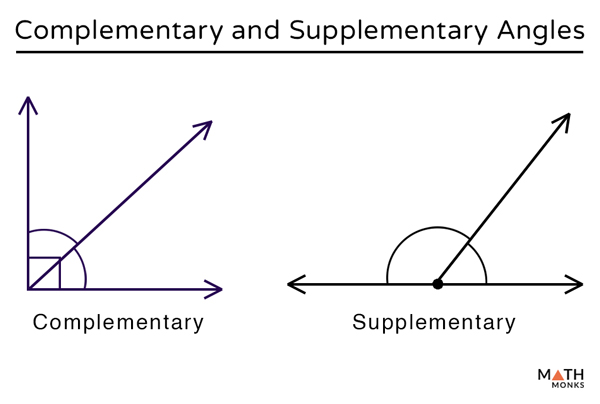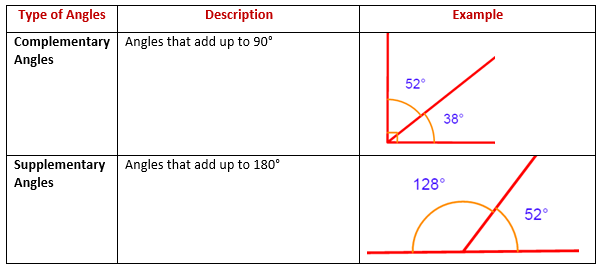Explain What Is the Difference Between Complementary and Supplementary Angles
When two line segments or lines meet at a common point called vertex at the point of intersection an angle is formed. Supplementary Angles are two angles that add up to 180 degrees.

Complementary And Supplementary Angles Turito Us Blog
But two supplementary angles might or might not form a linear pair they just have to supplement each other that is their sum should be 180o.

. If one angle is known its. 5 cm 15cm per month. The two supplementary angles if joined together form a straight line and a straight angle.
50 130 are supplementary. If one angle is known its complementary angle can be found by subtracting the measure of its angle from 90 o. What is the complementary angle of 43 o.
If the sum of two angles is 180 degrees then they are said to be supplementary angles which forms a linear angle together. 2Whenever two lines intersect they form two pairs of vertical angles. Two angles are said to be supplementary if their sum is 180 circ.
Difference Between Rate and Ratio Difference Between Square Meters and Meters Squared Difference Between Inverse and Reciprocal Difference Between Zero and Nothing Difference Between Geometric Mean and. For example angle 130 and angle 50 are supplementary angles because sum of 130 and 50 is equal to 180. Key Differences Between Substitute Goods and Complementary Goods The points given below are important so far as the difference between substitute goods and complementary goods is concerned.
Similarly complementary angles add up to 90 degrees. 1 90 comes before 180 on the number line. Goods that are perceived by the consumer as the same such that they can be used instead of one another and provide the same level of satisfaction are.
The difference is their sum. 15 75 are complementary. Supplementary and complementary angles do not have to be adjacent sharing a vertex and side or next to but they can be.
Linear pairs are any two angles that share a common ray and sum to 180 degrees. As adjectives the difference between supplementary and complementary is that supplementary is additional. Complementary angles sum to 90º like 30º 60º.
They both have similar concepts and theorems. Vertical angles are two angles whose sides form two pairs of opposite rays. Added together they form a straight line Two facts.
Often you can find them on a straight line however they dont always have to be together. Linear Pairs are a special subset of supplementary angles. Svetlanas hair is 4 4 centimeters cm cm long.
Linear pair is a pair of two supplementary angles. Complementary angles add up to 90. Furthermore all those angles which when summed up together produce the result of 90 degrees are called complementary angles.
Supplementary angles are two angles whose measures sum to a 180 degrees and complementary are the sum have to add up to 90 degrees. Complementary angles add up to form a right angle or gives 90 0 while supplementary angles added together gives 180 0. The sum of complementary angles is equal to 90 degrees while the sum of supplementary angles is equal to 180 degrees.
Vertical angles have a common vertex but they are never adjacent angles. Added together they form a right angle -and-. Supplementary angles are two angles with a sum of 180º.
Added to supply what is wanted while complementary is acting as a complement. However complementary angles form a right angle while supplementary angles form a straight angle or straight line. As a noun complementary is a complementary colour.
What is the difference between complementary and supplementary angles Brainly. Whereas if the sum of two angles is 90 degrees then they are said to be complementary angles and they form a right angle together. Supplementary angles are two angles whose sum is 180 degrees while complementary angles are two angles whose sum is 90 degrees.
While complementary angles complement each other supplementary angles supplement each other. SupplementaryAngles are any two angles that sum to 180 degrees. The complement of angle emptyset is left 90 circ emptyset right.
A complementary angle is an angle that adds up to 90 degrees. A and b are supplementary angles so ab 180 we know the difference is 88 so a - b 88 now if we rearrange the ab180 equation we can get an expression for b subtract a from both sides to get b 180-a if we substitute b into the equation a-b 88 we get a - 180 - a 88. On the other hand when the sum of two angles is equal to 180 degrees both of these angles are called supplementary angles.
Supplementary angles has the sum of the two angles that equal 180 degrees while complementary angles have the sum of 90 degrees between two angles. The difference is their sum. Supplementary angles together form a straight line whereas.
Svetlana wants her hair to be less than 1 6 cm 16cm long. Supplementary angles add up to 180. So a supplementary angle lies on a single straight line and a.
Two angles are said to be complementary if their sum is 90 circ. Supplementary angles are two angles whose measures sum to a 180 degrees and complementary are the sum have to add up to 90 degrees. Supplementary angles are those angles that sum up to 180 degrees.
Each pair form supplementary angles because their sum is 180o. Complementary angles and supplementary angles are quite different from each other. Her hair grows 1.
Supplementary angles add up to 180 degrees. 90 o - 43 o 47 o. There are four linear pairs formed by two intersecting lines.
Complementary angles are two angles with a sum of 90º. Write an inequality to determine the number of months m m svetlana can allow her hair to grow so that it is less than 1 6 cm 16cm long. Answer 1 of 2.
According to supplementary angle definition If the sum of the measure of two angles is 180 0 then the angles are said to be supplementary angles whereas according to complementary angles definition if the sum of measures of two angles is 90 0 then the angles are called complementary angles. There is a related link that can help explain. Two angles are supplementary if the sum of their angles equals 180 o.
Up to 25 cash back Hi Call one angle a lets make it the larger of the two angles and the other angle b. Two angles are complementary if the sum of their angles equals 90 o.

Complementary And Supplementary Angles Definition With Examples

Complementary And Supplementary Angles Lindsay Bowden Supplementary Angles Angles Math Maths Solutions

Complementary Angles And Supplementary Angles Video Lessons Examples And Solutions
No comments for "Explain What Is the Difference Between Complementary and Supplementary Angles"
Post a Comment